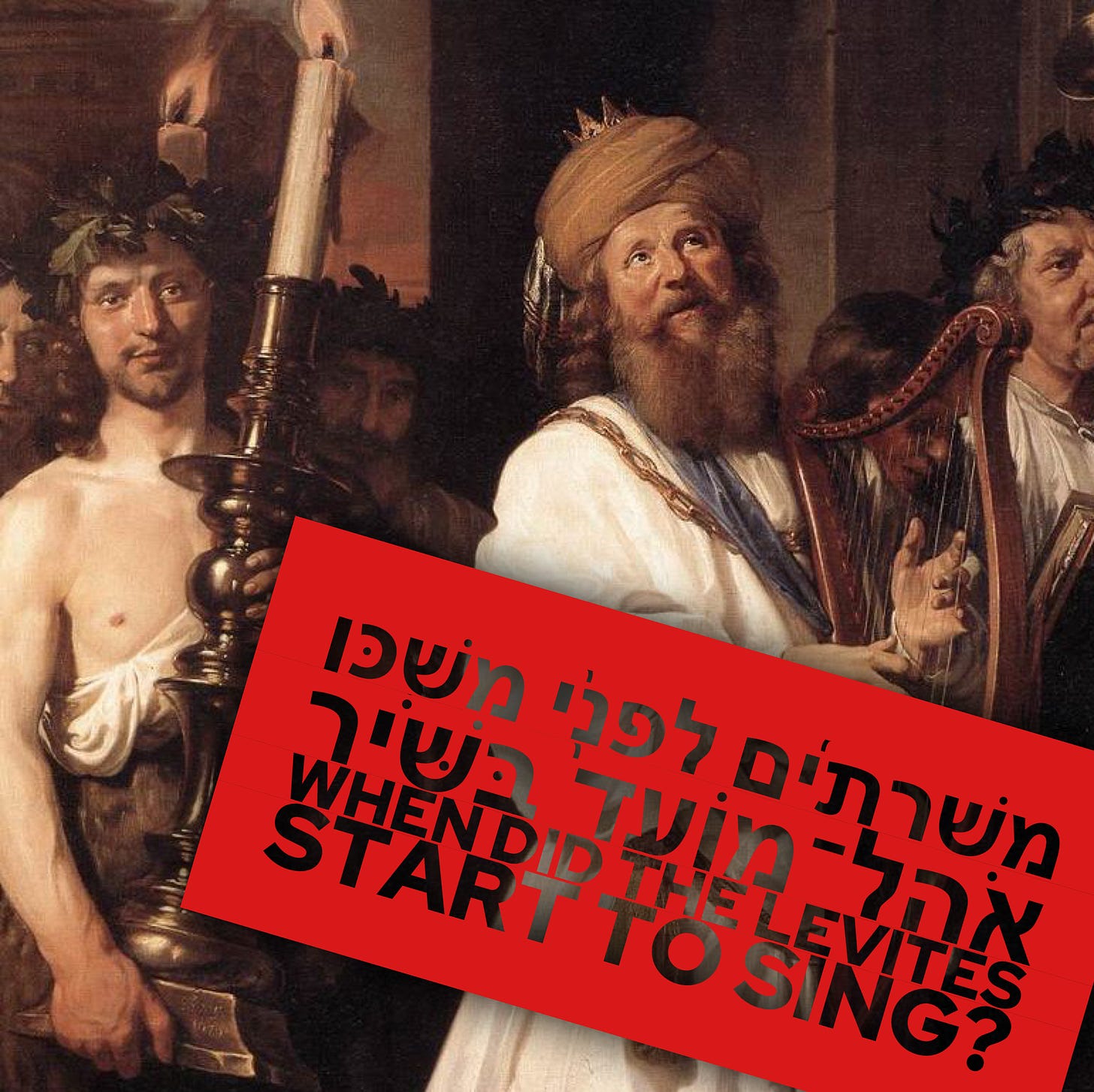When did the Levites start to sing?
Buried within the long lists and lineages of 1 Chronicles lies a verse that silently sings and possibly protests.
Among the names of those who belong to the tribe of Levi and designated temple technicians we meet the musicians: the Levites who ministered with musical instruments and vocal prayers.
These verses deserve a front row seat because behind the harp strings and harmonies is a deeper story — one of tension, territory, and theological turf wars.
1 Chronicles 6, especially verses 31–32, is more than administrative trivia. It is a strategic re-framing of Israelite identity, post-exile.
During the Second Temple period, starting with Ezra’s restoration, the Levites have additional roles and access to power. That may not have been the case during the first temple.
The Chronicler, writing centuries after Ezra, and many more centuries post King David, crafts a creative retroactive origin story for the Levites' rising role in temple life. This isn’t just about choirs and chords — it’s about power positions.
Since the monarchy that once symbolized the identity of the Israelites no longer existed in the Persian period, the only remaining unifying symbol was the temple. Therefore, ancestral temple- centered history narratives came into being. That included the intrigues and power-play-paradigms that often describe the politics of the palace -- here transformed to the temple courts. No more Saul vs. David, or South vs. North - but Levites vs. Priests.
In the Torah, Levites are assistants. Support staff. The priests — descendants of Aaron’s dynasty, father to son, are the elite corps who lead worship, offer sacrifices, and stand at the spiritual center.
Although both priests and levites come from the same tribe of Levi, same as Moses and Aaron - there were class distinctions with very different privileges and roles.
Many of these patterns carried on to the first temple. But by the time Chronicles is being written, the post-exilic Second Temple community in Jerusalem is redefining itself. Power structures are shifting. As noted by Jewish scholars like Sara Japhet and Jacob Wright, the Chronicler's agenda includes elevating the status of Levites — perhaps because, by the time of writing, they were doing much more than their earlier scriptural job description allowed.
This may have had to do with the model of Torah teaching that Ezra had already introduced- giving the Levites the role of Mavens - educators who operated outside the temple to provide literacy to the community - wherever they were. This may also have been connected to territory claims.
So what do you do when your present reality doesn't match your inherited tradition? You tell a new version of the past. In this case, the Chronicler inserts the Levites into David’s court, as official musicians of the sacred. Suddenly, their role isn’t minor — it’s central. Worship becomes not only about sacrifice but also about sound, song, and spiritual atmosphere. A new priestly paradigm is being tuned.
Even if music did play a part in the ancient worship and Levites of some sort played a part - this chapter is creating a retroactive system which may be much more elaborate than anything David or his heirs knew anything about:
וְאֵ֗לֶּה אֲשֶׁ֨ר הֶעֱמִ֥יד דָּוִ֛יד עַל־יְדֵי־שִׁ֖יר בֵּ֣ית יְהֹוָ֑ה מִמְּנ֖וֹחַ הָאָרֽוֹן׃ וַיִּֽהְי֨וּ מְשָֽׁרְתִ֜ים לִפְנֵ֨י מִשְׁכַּ֤ן אֹֽהֶל־מוֹעֵד֙ בַּשִּׁ֔יר עַד־בְּנ֧וֹת שְׁלֹמֹ֛ה אֶת־בֵּ֥ית יְהֹוָ֖ה בִּירוּשָׁלָ֑͏ִם וַיַּעַמְד֥וּ כְמִשְׁפָּטָ֖ם עַל־עֲבוֹדָתָֽם׃
These were appointed by David to be in charge of song in the House of the LORD, from the time the Ark came to rest.
They served at the Tabernacle of the Tent of Meeting with song until Solomon built the House of YHWH in Jerusalem; and they carried out their duties as prescribed for them.
I_Chronicles.6.18
The list goes on to describe a long lineage of names.
But the subtext? There were tensions. There were turf wars. The priestly Zadokite class may have resisted the Levites’ expanding influence. Music, after all, isn’t just background noise — it's ritual leadership, emotional power, spiritual authority.
As Japhet notes, these verses subtly craft a model of religious co-existence between the priesthood and the Levites, while also laying groundwork for a Levitical liturgy that became core to Jewish identity in the Second Temple period and beyond.
The contemporary takeaway for us seems obvious: Every system — religious, political, or artistic — evolves. Roles change. Authorities clash. But the question is not only who’s in charge, but who gets to change - and who gets to sing about it.
The Chronicler’s agenda was that healing after the destruction of the First Temple and exile included new models of leadership, new expressions of holiness, and new voices that rose to sing in holy harmonies, even if the harmony was partial, and hard-won. Who the Levites really were, how they evolved and what the role became during the second temple and after its eventual destruction is a rich topic of research. The story remains, the songs, such as the ones preserved in the psalms, are still with us, and the truth? it is somewhere in between the lines, a broken chord - that’s how the light gets in.
Below the Bible Belt: 929 chapters, 42 months, daily reflections.
Become a free or paid subscriber and join Rabbi Amichai’s 3+ years interactive online quest to question, queer + re-read between the lines of the entire Hebrew Bible. Enjoy daily posts, weekly videos and monthly learning sessions. 2022-2025.
Become a Paid Subscriber? Thank you for your support!
#Chronicles #BookofChronicles #IChronicles
#hebrewbible #כתובים #Ketuvim #Bible #Tanach #929 #דבריהימים #labshul #belowthebiblebelt929
#Ichronicles6
#levites #Levitesvspriests #kingdavid #songoflevites #templechoir #sing! #Zadokites #2ndtemple #sacredmusic #preachtothechoir
#peace #prayforpeace #nomorewar #stopthewarnow



